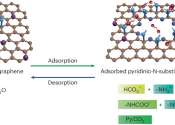Researchers suggest smart solution to harness waste heat from industry
Norway wastes huge amounts of energy. Surplus heat produced by industry is hardly exploited at all.
Jun 27, 2024
0
14
Energy & Green Tech

Norway wastes huge amounts of energy. Surplus heat produced by industry is hardly exploited at all.
Jun 27, 2024
0
14
Energy & Green Tech

Water electrolysis offers an ideal process for hydrogen production, which could play a key role in the global energy transition that increasingly relies on renewable electricity, but whose current production process is extremely ...
Jul 12, 2024
0
106
Energy & Green Tech

Scientists at EPFL have developed advanced atom-thin graphene membranes with pyridinic-nitrogen at pore edges, showing unprecedented performance in CO2 capture. It marks a significant stride toward more efficient carbon capture ...
Jun 24, 2024
0
68
Engineering

Computers, cell phones, and other electronic devices require active cooling to prevent overheating. Typically, devices in the entertainment industry and power electronics are cooled by directing an airflow to specific areas. ...
Jun 25, 2024
0
6
Engineering

A research team led by Dr. Sung Mook Choi of the Korea Institute of Materials Science has developed a one-step electrode fabrication process for the first time in South Korea. The research is published in the journal Applied ...
Jul 15, 2024
0
7
A membrane is a layer of material which serves as a selective barrier between two phases and remains impermeable to specific particles, molecules, or substances when exposed to the action of a driving force. Some components are allowed passage by the membrane into a permeate stream, whereas others are retained by it and accumulate in the retentate stream.
Membranes can be of various thickness, with homogeneous or heterogeneous structure. Membrane can also be classified according to their pore diameter. According to IUPAC, there are three different types of pore size classifications: microporous (dp < 2nm), mesoporous (2nm < dp < 50nm) and macroporous (dp > 50nm). Membranes can be neutral or charged, and particles transport can be active or passive. The latter can be facilitated by pressure, concentration, chemical or electrical gradients of the membrane process. Membranes can be generally classified into three groups: inorganic, polymeric or biological membranes. These three types of membranes differ significantly in their structure and functionality.
This text uses material from Wikipedia, licensed under CC BY-SA